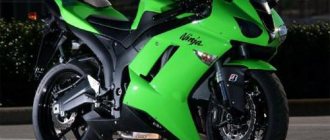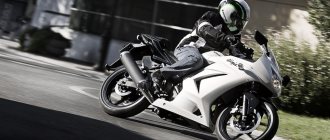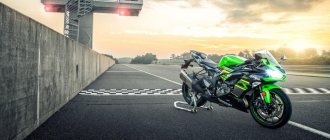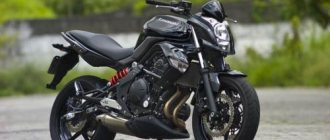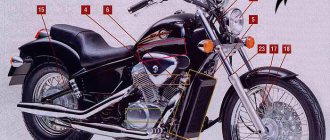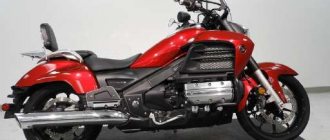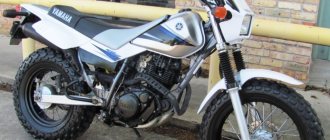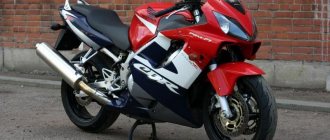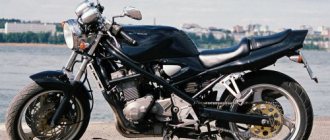In addition to the purchase history, I will try to reveal in more detail the objective (and not so objective) sides and share useful observations. There are a lot of letters, photos, videos under the cut.
How and why.
I took the Minstrick VFR800A instead. The wheel was excellent, in perfect condition, especially after I replaced all the consumables possible)) I rode it for most of the season, it made me quite happy. But there were reasons to change seats:
- vyfer, I planned to use 60/40 city/highway, prepared it for this (case, seat, electrical wiring for additional equipment), but it turned out that there was no time to drive long distances, and I didn’t really like it in traffic jams - it It’s a bit heavy, has a fairly high center of gravity, and gets very hot.
- the seating position is still almost sporty (inclination is 25-30 degrees), and my +1 is 154 cm tall, and sitting in the back, I stupidly can’t reach the tank properly with my hands
 . Either I have to bend down very much myself, or she holds on to the handles and leans her back on the case But pretty soon your arms get tired, and when maneuvering it starts to wobble like a sack of potatoes. In general, riding together on a wheel somehow “didn’t work out.”
. Either I have to bend down very much myself, or she holds on to the handles and leans her back on the case But pretty soon your arms get tired, and when maneuvering it starts to wobble like a sack of potatoes. In general, riding together on a wheel somehow “didn’t work out.”
So, if I were completely selfish, I would continue to travel. But there are a lot of motorcycles, each is good in its own way, but I want to try them all! I remembered how we rented a Honda Shadow on vacation, drove about 1000 km around Cyprus together, we liked it quite well, and with the backrest sitting in the back it was almost possible to put on makeup on the go. The selection criteria were: to drive not like a vegetable, and to steer normally; The style is not classic, with a minimum of chrome (that is, a power cruiser). I wanted a motorbike in excellent condition, without the expected high costs and maintenance hassles, so that it would be easy both in traffic jams and on long trips. Mean streak and more or less Warrior fit well into the budget. VTX-F – with high interference. V-rod, Bull - also different money, you could strain and find it, but I don’t see versatility in them, I can’t imagine how I would drive them every day.
I started looking and searching. Then a good option turned up - Minstrik SE, the owner let me take it for a ride, I didn’t see any problems. The vyfer was quickly sold, and this is what I bought:
I didn’t take this photo and the title page, but since the subject of the photo is now mine, I think I can use them 
Kawasaki VN 1600 Mean Streak '2008 SE (Special Editon). The previous owner lived in Canada, bought it there, drove it for 3 years and brought it with him to Moscow. I checked it using Carfax - indeed, it was under arrest for a long time, then sold at auction, with 900 miles on the clock. I got it with just under 12,000 miles on it.
Performance characteristics and features.
The full list of performance characteristics, as well as the differences from the VN1600 Classic, can be easily googled; I will just give my impressions and observations after a little over 11,000 km of driving on it.
I’ll say right away that I’m not an inveterate chopper driver, and I’m basing this on a comparison with a road/sport tourer. If we regard Minstrick solely from the point of view of a cruiser, it drives, brakes, and steers at 200%. Dynamics: when compared with other classes, then, in general, the dynamics are approximately at the level of a road driver 500-600cc. Minstrik does not boast of outstanding acceleration characteristics or ¼ mile time... whatever one may say, after sports this cruiser does not move, despite the power prefix. But there are no problems - the dynamics are quite sufficient for driving in any conditions; most cars lag behind at a traffic light. If we compare, for example, with the FZ1, then from the start I go ahead for a short time, then from 60-70 mph it leaves me behind.
Minstrik does not boast of outstanding acceleration characteristics or ¼ mile time... whatever one may say, after sports this cruiser does not move, despite the power prefix. But there are no problems - the dynamics are quite sufficient for driving in any conditions; most cars lag behind at a traffic light. If we compare, for example, with the FZ1, then from the start I go ahead for a short time, then from 60-70 mph it leaves me behind.
My maximum speed without a windshield, at full stock = 200 km/h (125 mph), maybe I could fire up another 5-10, but there’s no point in torturing the horse like that. And this speed feels completely different from a sports tour... I don’t want to go faster anymore))
Meaty torque is nice. But its peak is at fairly low speeds (~2800) and if you’re not used to it, this can bring unexpected surprises, especially to those who have previously driven in-line vehicles. On wet asphalt, markings, sand - when starting in 1st gear, the rear can slip easily. It is also better to shift downwards with a “re-throttle”. I can do this automatically.
The clutch is hydraulic, at some point it began to slip, later an autopsy showed fairly worn friction discs, deformation of one of the small disc springs and an almost flat main spring. It’s quite a common situation, the clutch on such motorcycles is generally consumable... well, depending on how you ride, of course. In general, there is such an opinion that the original spring is initially weak, and it is installed slightly slipping from the factory, as a “foolproof” so that an inexperienced rider does not let the wheel slip every time he shifts down. Instead, I ordered and installed a complete Barnett kit. Very informative, the “gray zone” is well felt, acceleration is as it should be. But the lever became wildly tight, at first in a traffic jam after 5-10 minutes the left claw simply withered and refused to work)) then I got used to it, and the spring developed a little, now I drive without any problems. Let's see how much is enough.
The box works clearly, nothing to say. I would like only 6th gear. It is also worth noting about this Kawasaki feature - “positive neutral finder”. Its meaning is that while standing still, you can only shift from 1st gear to neutral. Once you stop, you can pull your paw up without thinking. The high torque and low revving engine can make it difficult to know what gear you're in. Over time you get used to it and understand it intuitively. Or looking at the dash: 4000 rpm = 70 mph in 4th gear = 90 mph in 5th gear
I would like only 6th gear. It is also worth noting about this Kawasaki feature - “positive neutral finder”. Its meaning is that while standing still, you can only shift from 1st gear to neutral. Once you stop, you can pull your paw up without thinking. The high torque and low revving engine can make it difficult to know what gear you're in. Over time you get used to it and understand it intuitively. Or looking at the dash: 4000 rpm = 70 mph in 4th gear = 90 mph in 5th gear
brakes are 4-piston radial, with upside-down forks - the same as on the ZX-6R '03-06 and ZX-10R '04-07; at the rear is a two-piston caliper. The brakes are wonderful, but I would like to have more power (although I’ve already broken my lip). Contrary to the popular belief that on a chopper you should brake more with the rear, here you can and should brake according to the classic rule - with both brakes, starting with the rear, and applying increasing force to the front. The rear without the front is only sufficient for a standing traffic jam, slowing down or driving “pull”. The motor is heavy, the traction is strong, so in order to brake properly, you need to squeeze the clutch. If you don’t do this, then the brakes are of little use; all you can do is adjust the speed/trajectory. I installed reinforced hoses - nothing really changed. Braking must be calculated in advance, as with any heavy and powerful motorcycle.
Suspension: 43 mm upside-down fork – no adjustments, but no complaints about it – works great in any conditions, the rigidity is sufficient, and it compresses smoothly under heavy braking.
Shock absorbers are paired gas-oil shock absorbers, rebound adjustment is done with a wheel in 4 positions, and preload is adjusted by pumping air from 0 to 3 atm. I'm not happy with the shock absorbers. I turned the release button, tried all the positions, but didn’t notice any difference. Pumping air is a terrible hemorrhage - the volume of the tank is extremely small; when the nozzle is removed, almost all the air that was pumped can escape from the fitting. Because of this, it is difficult to set the desired pressure, and even more difficult to ensure that it is the same on both shock absorbers. In addition, when pumping with a compressor, high pressure can easily knock out the seals. Therefore, you need to look for a special pump for shock absorbers (sometimes used by cyclists).
On uneven surfaces (bumps, ruts) in a long turn, the bike can be unstable and the rear sways unpleasantly. I had an assumption that the shock absorbers were faulty, but I didn’t notice any oil leaks, they didn’t break through on strong bumps (that is, something was still damping), the mechanics whom I showed and asked a question shrugged their shoulders. And in general, everyone tells me - well, what did you want, this is a chopper. But I love it when everything is perfect. I think I’ll buy and install new good progressive ones and see what changes.
Tires - standard sizes are quite rare: 130/70 R17, 170/60 R17. But they can be replaced without any modifications by the more popular 120/70 and 180/55, and the handling will not be affected enough to be noticeable. I got the bike with fresh Avon Storm 2ST - excellent tires, I ride in any weather, rain and even snow (if I'm unlucky). The main thing is to brake carefully, avoid markings, etc.
Control and comfort.
Seating position: The footpegs are positioned in a cruiser-style “middle control” position, which is generally considered to improve handling.
The steering wheel is a drag bar stick. The general layout is such that you have to noticeably reach for the steering wheel. The seating position, given my height of 179 cm, is slightly tilted forward, which is comfortable both during acceleration and braking. People with a height of less than 175, I think, will not be comfortable on it. From old memory, I often hold the tank on it with my knees, when cornering or if I’m driving 160+)) The stock seat is excellent, both in terms of comfort and design. I tried to sit on others - the Mustang seemed a little stiff, and the Corbin was generally like wood... I don’t plan to change.
The second room is not as comfortable as on a classic cruiser, but after a road bike/sport, this is simply the height of comfort. The legs are bent at a noticeable angle, there is not much space in the seat - this encourages the passenger to sit closer to you and squeeze her thighs tighter 
The levers and remote controls are completely ordinary, like on any classic/cruiser. Hazard lights and blinkers under the far index finger - no. There is a function to automatically turn off the turn signals. The speedometer and odometer are in miles, at first you get confused, then you get used to it, now it doesn’t matter to me, I quickly convert miles into km.
The ignition switch is made in the form of a twist, which can be turned from the “off” position only with the key, and back - regardless of its presence. The key can be pulled out at any time. That is, he turned on the ignition, put the key in his pocket, and drove off. I arrived, turned the knob, turning off the ignition. It's very convenient, I quickly got used to it. Don't forget the key in the lock. This happened to me several times with other motos. When you arrive, leave, after a few hours you realize that you left the key in the lock - you can turn gray. On the other hand, if you lock the steering wheel, you still have to take the key out of your pocket again. And if you leave it in the lock while driving, there is a risk that it will fall out on a large bump, especially if the bunch is heavy.
The key can be pulled out at any time. That is, he turned on the ignition, put the key in his pocket, and drove off. I arrived, turned the knob, turning off the ignition. It's very convenient, I quickly got used to it. Don't forget the key in the lock. This happened to me several times with other motos. When you arrive, leave, after a few hours you realize that you left the key in the lock - you can turn gray. On the other hand, if you lock the steering wheel, you still have to take the key out of your pocket again. And if you leave it in the lock while driving, there is a risk that it will fall out on a large bump, especially if the bunch is heavy.
vibrations , even at idle it shakes noticeably, and the strongest ones are at 2000 rpm (this is the norm... confirmed by other Minstreak owners). For this reason, the picture in the mirrors is often blurred, so you need to turn your head more, or let off the gas a little - everything is clear during engine braking. At first, the vibration made my hands go numb)), then I got used to it and didn’t pay any attention at all. On a long trip they are not annoying. Well, the passenger generally likes it.
steers quite specifically, but it is simpler and more enjoyable than a classic cruiser. When cornering, it's easy to lean into the footpegs, which scrape the asphalt and fold down. It can be driven relatively quickly and dynamically, but this depends on the rider. It’s clear that it is not suitable for series of plunges and braking “on the horns”. I would define a comfortable speed up to about 150 km/h, then it blows quite a bit, at this speed it is already controlled like a flying iron, if you go faster, it’s better to go straight) In general, my speed limit didn’t change much after the switchback.
In the city: the width of the steering wheel is slightly more than 70 cm, my mirrors slightly extend beyond the dimensions of the steering wheel, but this depends on which ones to install. That is, the motorcycle is narrow and long, it rides easily in between rows. It’s even easier for me in a traffic jam than on a wheel, due to the low center of gravity. Changing the row, of course, is difficult, due to the long wheelbase and the characteristic cruiser “break” of the steering wheel in extreme positions at near-zero speeds, due to the increased offset and fork angle compared to the road bike. In a very dense traffic jam, such as Tverskaya, or an exit where cars climb in three rows, of course, it’s a bit difficult - due to the large mass and tight clutch.
Without traffic jams along the avenues and boulevards - there’s nothing to even say - this is his native element.
Consumption in heavy traffic is from 7.5 to 8.5 l/100km. In the city I fill up about once every 170 km.
On the highway: with a windshield, a comfortable speed of up to 150 km/h, consumption at this speed is ~6.6 l/100 km. There is some confusion with the volume of the tank: the passport volume = 17 liters, but when I completely dried out in Belarus, I added 0.5 liters of gasoline to the tank and twitchingly made it to the gas station - only 14.7 liters fit into the tank, that is, the real volume turns out = only 15 liters. A full tank is enough for 230 km in 145-150 mph mode. If you drive slower, it should be enough for at least 250 km. But it’s still more convenient to make stops every 200.
Now I know that in Belarus there are very long sections without gas stations))
There is enough comfort, you can drive 800 km a day without straining too much. Only the shoulder girdle gets tired over time, due to the specific fit. The seat is quite wide, you can change your position on it back and forth, your legs can be straightened, relaxed and placed on top of the footrests (only after 140 they begin to deflate). All this is true for one rider, with +1 I wouldn't go very far on it. Maximum 300-500 km.
Luggage: I almost always drive around the city with a Vanucci VSR03 bag in the back seat, its volume is up to 20 liters, there is a neon mini rain cover. The “platform” is fastened with 4 belts, and a bag is attached to it with a zipper. The bag has straps separate from the platform, i.e. like a backpack. Very convenient, and even in color)) When I go further away, in addition to it, I hang 2 small Louis textile trunks of 15 liters each on the sides. All this is enough for one person, if you take a tent/sleeping bag/foam - they can be tied on top.
I hang glass and bags only when absolutely necessary...
The only thing missing is the heated handles, but that’s overkill, I don’t want to make a tourist out of it. I arrived, took off the windshield, panniers, holder for the navigator - and again it was a city muscle bike.
It is better to avoid bad and broken asphalt, off-roading - if only light, a few kilometers from the asphalt to the destination. But in general it depends on the condition of the road and your persistence:
in the video there are some traffic jams, a highway, a forest, dirt, night, rain, obscene language and a hedgehog
Service. Minstreak is a simple, iron bike, everything is within easy reach.
To change the spark plugs, remove the cap and unscrew the spark plug. Oil - unscrewed the plug, unscrewed the filter, drained it, refilled it. The oil in the gearbox is the same, the plug is on the outside. The battery and all electrical components are located under the seat - unscrew 3 bolts. Air filter - unscrewed 1 bolt, removed the cover on the left between the cylinders, and here it is. On the left side there is a glove compartment - it opens with the ignition key, inside there is a loop under which you can push something useful, such as a net or rope, and a mini-compartment closed with a lid - a standard pencil case with tools fits there. On the starboard side there is a similar cover - under it there is an expansion tank and a fuse box - to add antifreeze, you need to unscrew 1 bolt and remove the cover. I am not aware of any significant “sores” of this model. On the previous generation (VN1500 MS), many people complain about the fuel pump failing; I haven’t seen such reviews about the 1600.
One of the peculiarities can be noted - sometimes it happens - after a long drive in heavy traffic or a traffic jam, in the heat of 28+ degrees, when you turn off the engine, you can hear a slight whistle from the gas tank cap. This occurs due to an ill-conceived valve design for equalizing gas pressure. On foreign forums it is called “Vulcan Whistle”. After 5-10 minutes it goes away on its own, or you can help - open the lid and equalize the pressure.
Due to vibrations, the muffler cover clamps can become loose and produce squeaks and whistles - to prevent this from happening, you need to loosen them, fasten them properly and tighten them firmly with a thread locker. The headlight also whistled due to vibration (disassembled, lubricated, glued the seal) and the license plate broke in half)) I made a duplicate, strengthened the mount and put everything on Loctite.
When falling, if there are arcs, only the muffler suffers (its shields are scratched), levers, headlight, fender. The motorcycle is solid and strong, cosmetic defects can be easily eliminated, the body kit can be found at a disassembly site or ebay, or replaced at an aftermarket.
Appearance.
I don’t like the appearance of classic cruisers, I don’t like the abundance of chrome and the “hippopotamus” look, so I looked at the SE.
The 2008 version - with a black tank and a laconic Special Edition inscription (in 2007 there was a “flame” on the tank and wing, for me it looks a little ridiculous). In my opinion, the windbreaker, saddlebags/bags, and backrest disrupt its compressed, “charged” silhouette and make the bike more “retired.” Although I still usually travel with a bag in the back seat - it’s more convenient than with a backpack. He's more beautiful in person. In general, in many of the photos above, because of the angle and the camera, it seems to be “compressed”. In fact, the mot is quite long and low.
The SE version is rare, and the 2008 version is very rare. I have never seen a second one like it in Moscow - neither on the street, nor in salons. The black exhaust pipes are actually just covers. Below them are real pipes of smaller diameter made of stainless steel, according to the 2-1-2 scheme. I have not planned to install forward flow yet. The 1.6l engine already sounds quite serious.
Arches for Minstrik can be found in 3 main forms, if you do not take into account custom-made ones:
- semicircular “bugs” on each side, for example, the original Kawasaki, Cobra - for me, they don’t look very good on Minstrike, although they provide the best protection. There is also a drawback - the arches, which are lower than the pegs, will interfere with cornering. If without them, with a strong tilt, the footrest folds, you lift your leg, scrape it a little and then move on - then with an arc this is already fraught with a fall.
- Lindbar and their analogues. For example, in the Vilar workshop they make arcs of this shape from thick pipes. I didn’t like it, everything is similar to “burdocks”.
- “Upper mugs,” let’s call them that. I liked them the most - they protect the tank and covers, they don’t interfere with the folding of the footrests, they look normal. Hepco&Becker, Fehling. I took the last ones for myself and powder painted them black. But it’s uncomfortable to put your legs on them - too high.
Consumables: Little by little I collected a small list of the main consumables - all of this can be Googled, but cannot be found in one place. It may be useful to someone.
- Spark plugs: NGK DPR6EA-9, 4 pcs.
- Pads: original Kawasaki – 43082-0031 (front), EBC – FA369 front / FA231HH rear, TRW – MCB843SH rear, SBS 704 front, Ferodo FDB2049 front, Nissin 2P-257 front, CL Brakes 1110 SBK/A3 front / 2384 rear
- Hiflo filters – air HFA2911, oil HF303
- Clutch: Cover gasket – 11061-1081 Barnett spring 502-00-01025 Friction discs: original 13088-1146, Barnett 302-45-20018, EBC – CK4455, TRW – MCC230-8, FERODO – FCD0416, VESRAH – VC-462, PC-462
- Tourmax caliper repair kits: BCF-424 – for both front calipers. BCR-412 – rear caliper. or the rear can be replaced with a BCF-413, everything is identical, only one cap instead of two.
- Oil 3.5l, I use 10w40 in spring and autumn, 15w50 in hot summers
- Any gear oil GL-5 SAE80w90 200 ml.
- Antifreeze volume = 2.3l (full replacement)
What's the result? if you want to rush out of traffic lights and tear up sports, you won’t like this bike, take the V-MAX or M109R.
If you want to travel, a tourenduro is better; commuting most of the time during rush hour, a naked bike is better... Well, the Minstrick is a universal motorcycle for every day. He has his own special charisma. People pass by and crane their necks. When you are on it, your cabbage soup automatically becomes complex. It has good dynamics, handles well, can be used in traffic jams and on a long trip, you can take your girlfriend along the embankments in style. And then drive off along the highway into the sunset.
MEAN STREAK
In the late 80s, bass guitarist Peter Andersson played in the band Axia, but after its collapse he moved away from show business. Nevertheless, his heart still remained true to eighties metal, and in the mid-2000s he decided to return to his favorite pastime. The first song that Peter composed was “Rock City,” but when the bass and guitar parts were written, high-quality vocals were required, and Andersson turned to Andi La Guerin for help. He not only coped with the task perfectly, but, imbued with the atmosphere, came up with another piece in a similar style, which was called “Carved In Stone”.Then things started snowballing, and the musicians composed the third composition (“The Seventh Sign”) as a couple, after which they began to think hard about founding a joint team. Nevertheless, Peter and Andi spent another six months accumulating material and only then called in their longtime friend drummer Jonas Kallsback for help. Having prepared about a dozen tracks, the trio decided to put some extra polish on them and gave the compositions to producer Fredrik Nukström for further development.
In the end, the process resulted in the creation of the album “Metal Slave”, and when the team decided to perform in public, second guitarist Yngwe Frank joined its ranks. The concerts were quite successful, and the owners of the club that gave Mean Streak a start in life financed the first 500 copies of the disc, after which the group received a normal contract from Black Lodge Records. The NWOBHM-influenced "Metal Slave" received a warm reception in both the European and Japanese markets, with trade publications giving it good reviews and 89/100 "Burrrn!" Andi subsequently focused on vocals, and instead of the departed Yngve, guitarists Dovid Andersson and Potrik Gardberg appeared on the staff.
However, the renewal of the line-up at that time did not affect the sound in any way, and on the disc “Declaration Of War” the team again paid tribute to eighties metal, and in reviews of the album parallels with “Saxon” again appeared. The release of the second full-length was supported by the first European tour, and in addition, “Mean Streak” visited Japan. As the tour progressed, another change occurred, and Gardberg's place was taken by Thomas "Plec" Johansson.
When Andersson and his new guitarist were on vacation in Thailand in 2012, they began preparing material for the third album, and their joint work marked some changes in style. And although the program “Trial By Fire” opened with the high-speed action song “We Are One,” many of the songs had a mainstream flavor and gravitated toward AOR. It is also worth noting that Peter also left personal experiences on the album, and if the song “Shine On” was written under the impression of a recent divorce, the musician dedicated the acoustic ballad “Cast Away” to his deceased mother. Andersson prepared the material for the fourth studio album alone, but this time he chose sunny Spain as the place to write songs, and therefore “Blind Faith”, unlike its predecessor, turned out to be more positive.
By the beginning of the sessions, Dovid had quit his job and the well-known Max Norman (Ozzy Osbourne, Megadeth) acted as producer. In 2018, Johansson was replaced by Julian Eriksson, and a couple of years later Fredrik Held found himself behind the drum kit. Despite the updated half of the line-up, “Mean Streak” remained true to their roots and on “Eye Of The Storm” they offered listeners another portion of their signature pro-eighties metal, flavored with splashes of hard rock and AOR.
Last update 11/21/20
